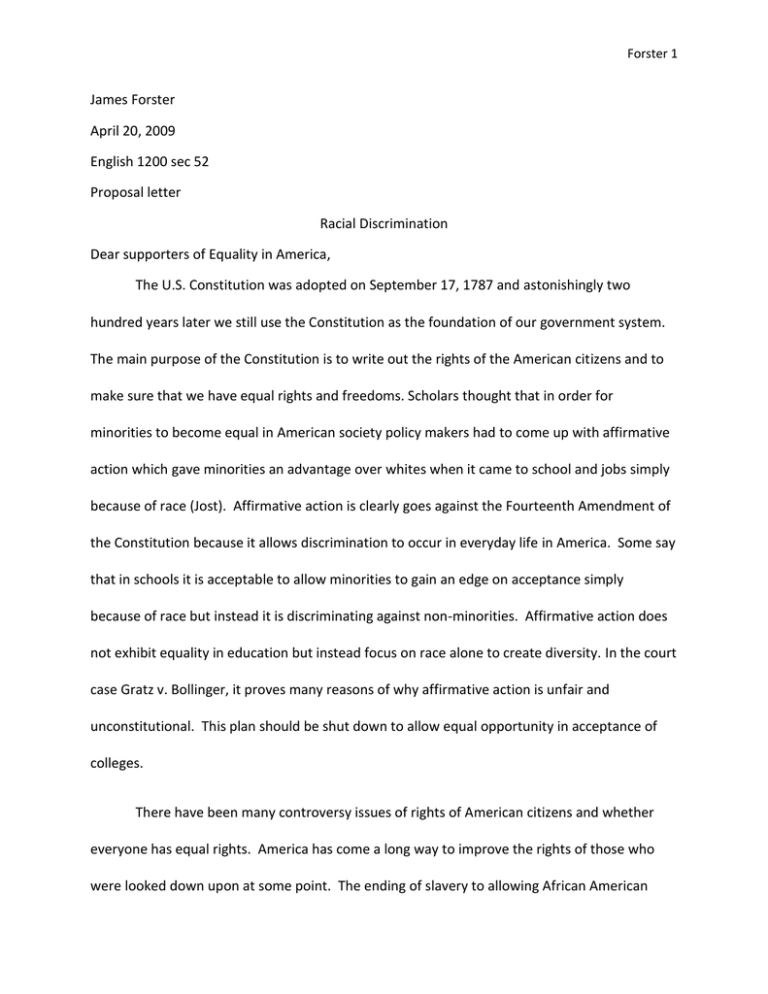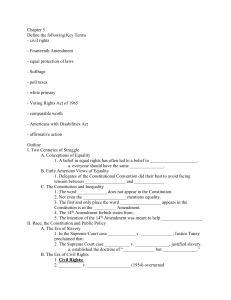Affirmative Action
advertisement

Forster 1 James Forster April 20, 2009 English 1200 sec 52 Proposal letter Racial Discrimination Dear supporters of Equality in America, The U.S. Constitution was adopted on September 17, 1787 and astonishingly two hundred years later we still use the Constitution as the foundation of our government system. The main purpose of the Constitution is to write out the rights of the American citizens and to make sure that we have equal rights and freedoms. Scholars thought that in order for minorities to become equal in American society policy makers had to come up with affirmative action which gave minorities an advantage over whites when it came to school and jobs simply because of race (Jost). Affirmative action is clearly goes against the Fourteenth Amendment of the Constitution because it allows discrimination to occur in everyday life in America. Some say that in schools it is acceptable to allow minorities to gain an edge on acceptance simply because of race but instead it is discriminating against non-minorities. Affirmative action does not exhibit equality in education but instead focus on race alone to create diversity. In the court case Gratz v. Bollinger, it proves many reasons of why affirmative action is unfair and unconstitutional. This plan should be shut down to allow equal opportunity in acceptance of colleges. There have been many controversy issues of rights of American citizens and whether everyone has equal rights. America has come a long way to improve the rights of those who were looked down upon at some point. The ending of slavery to allowing African American Forster 2 males to vote, separate but equal schooling, and allowing women to vote ere all steps toward equality. America is accepting diversity into its country realizing diversity broadens the education base by bringing together people from different backgrounds and beliefs. In this day in age even though discrimination may still be present within peers, the government over sees the public such as stores and restaurants to prevent discrimination against customers based on race, color, religion, sex, or natural origin. Affirmative action means to take positive steps to increase the representation of women and minorities in areas of employment, education, and business from which they have been historically excluded (Conference). This plan is a very controversial issue because some say that it improves diversity within the nation as others say that it discriminates against nonminorities (Messerli). When looking at the educational benefits of affirmative action, supporters believe that in undergraduate admission that it is a good idea to consider race because race is likely a large part of who a person is as a whole. They also believe that having more diversity within the student body will improve the education level by providing more diverse backgrounds and sharing their different experiences in life. Most opponents believe that diversity is extremely important in a higher education institution and that some type of policy or program needs to be in place to encourage equal opportunity, especially for underserved populations and areas. Universities and colleges may be more successful if they engage in race-neutral recruitment to enlarge the pool of qualified applicants, including minority candidates (Conference). These programs award students who graduate in the top percent of their class by providing automatic admission to one of the public universities in the state. California, Texas and Florida have replaced their affirmative action policies with their own Forster 3 variation of percentage plans, which respectively admit the top 4, 10 and 20 percent of a graduating class (Conference). It would give all students incentive to work hard in school and give all races and equal chance. In the United States, affirmative action in undergraduate admissions states that colleges are permitted to consider race as a factor, but banned racial quotas, by not allowing them to reject applicants merely on race (Katel). The University of Michigan as well as other universities currently has a system in place which gives advantages to minority applicants on the basis of their race. The University has considered African-Americans, Hispanics, and Native Americans to be “underrepresented minorities.” The current guidelines use a selection method under which every applicant from an underrepresented racial or ethnic minority group is automatically awarded 20 points of the 100 points needed to guarantee admission. This system brought up a very controversial case in 2003 (Gratz v. Bollinger). Former applicant to the University of Michigan, Jennifer Gratz, brought suit to the university and won when a federal judge ruled that their polices mirrored a quota system. The ruling however, allowed the university to continue to use race as an admittance factor (Jost). The U.S. Supreme Court has ruled multiple times that schools are able to use race as a factor to admissions in order to keep schools diverse, as long as it is not a determining factor. The Supreme Court held that the university’s racial preference violates both the Equal protection Clause and Title VI, which prohibits discrimination based on race (Jost). The Fourteenth Amendment is intended to protect our rights as citizens of the United States such as the equal protection laws. Within the Fourteenth Amendment it reads, “No Forster 4 discrimination shall be made by any state, nor by the united States, as to civil rights of persons because of race, color, or previous condition of servitude” (Mount). The Constitution also states that any privileges on account of “race, color, or creed, shall be inoperative and void” (Mount). When talking about affirmative action it is difficult not to see that it is unconstitutional because it is doing exactly what the constitution says not to do, which is to discriminate. When the University of Michigan agreed to automatically award “underrepresented minorities” twenty of the needed one hundred points to guarantee admission strictly because of their race (Jost), they decided to put aside the Constitution that says not to discriminate against race. Even though you are discriminating against whites it’s still discriminating against a certain race and not giving an equal opportunity for all people. Affirmative action is designed to end discrimination and unfair treatment of employees/students based on color, but it in effect does the opposite. Whites who work harder and/or are more qualified can be passed over strictly because their white. Contrary to many stereotypes, many minorities fall into the middle or upper class, and many whites live in poverty (Messerli). Before the issue was addressed people were discriminating against minorities but now since the pendulum is swinging the other way, they forget that they are discriminating against whites. Whether you’re a supporter of affirmative action or against it there is no denying the unconstitutionality of the practice. It’s clear that the University of Michigan’s policy was unconstitutional just by comparing their policy to the Constitution. I don’t believe it is fair to students who work hard in school to not get an equal chance in admissions as do minorities. I understand that there are many Forster 5 minorities who are less fortunate but I think there should be a better policy that could base it on household income since that would show the poverty level of the students. If you simply base it off of race, there could be an instance between a rich African-American and a poor white kid and because of the African-American’s race they will have the upper hand. A more balanced approach to gaining diversity would be taking socioeconomic status into account. Taking socioeconomic status into account would be a better plan because it is an economic and sociological combination that shows the total measure of a person's work experience and of an individual's or family’s economic and social position relative to others, based on income, education, and occupation. Using this method I believe that you would be able to tell who was less fortunate in their earlier education by looking at their socioeconomic status. It would take in account a person’s ability to overcome obstacles as well as propel diversity on college campuses (Jost). Relying on this method would be much more constitutional since it would not rely on race alone. Even though that it is clear that something must be done in order to maintain diversity in education focusing on socioeconomic status is the way to go. Affirmative action simply discriminates against whites when the whole point of the policy to gain citizenship back for those who have been discriminated themselves. When you turn down students because there are said to be too many white students, then that in turn just lessens diversity because diversity is not just about skin color it’s about a person’s background and experience that they will be able to share with others. America has come this far too stopping discrimination of race so why start the cycle over again. Forster 6 Works Cited Conference, National. “Affirmative action overview.” National Conference of State Legislatures. 2009 <http://www.ncsl.org/programs/educ/AffirmativeAction.htm> Gratz v. Bollinger. No. 02-516. Supreme Ct. of the US. 23 June. 2003 Jost, Kenneth. “Affirmative Action in Undergraduate Admissions.” CQ Researcher 11.32 (2001): 737-760 CQ Researcher Online. 21 Sep. 2001 <http://library.cqpress.com/cqresearcher/cqresrre2001092100> Katel, Peter. “Affirmative Action.” CQ Researcher 18.36 (2008): 841-864. CQ Researcher Online. 19 Mar. 2009 <http://library.cqpress.com/cqresearcher/cqresrre2008071800> Messerli, Joe. “Should affirmative action policies be eliminated.” Balanced Politics 01 Mar.2009 <http://www.balancedpolitics.org/affirmative_action.htm> Mount, Steve. “The United States Constitution.” U.S. Constitution Online. 24 Mar.2009 <http://www.usconstitution.net/>






